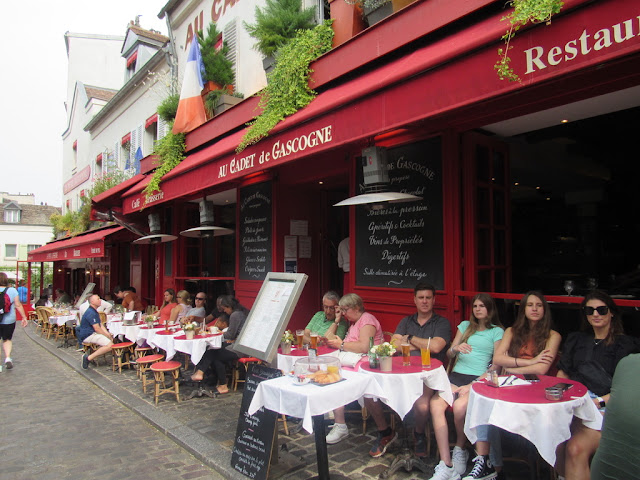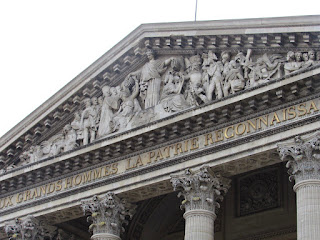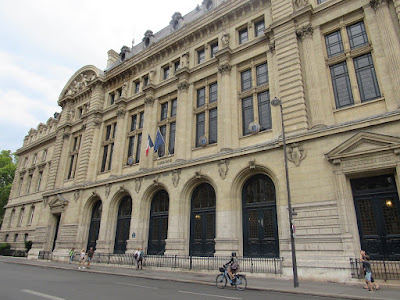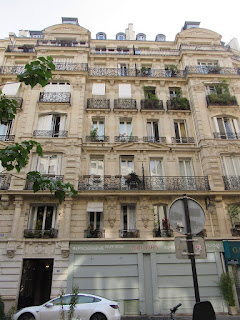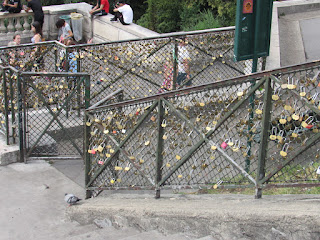
Paris is so big and so filled with things to do that it's probably best to go there several times over a lifetime. I have tromped through this fabulous city twice and concentrated on tourist sites and important museums. On this third time in the city I saw some things I hadn't seen before and experienced a bit of night life that makes the city so attractive to residents and tourists alike.
 I was fortunate to be traveling with a small group of people, many of whom were women from different parts of the world. One of the highlights of my time in Paris was to go to a piano bar on the Left Bank. Ida, (left) a retired corporate attorney from South Africa, has traveled through Paris at least 20 times over the past few decades. She has become familiar with the Latin Quarter stores, restaurants, and night spots there. She took Simone (right), an Australian elementary teacher, and me on a little tour of the area before we stopped for dinner at Le Paris Paris Café & Restaurant. After dinner we made our way to the Aux Trois Mailletz piano bar for a drink, a listen, and some great fun.
I was fortunate to be traveling with a small group of people, many of whom were women from different parts of the world. One of the highlights of my time in Paris was to go to a piano bar on the Left Bank. Ida, (left) a retired corporate attorney from South Africa, has traveled through Paris at least 20 times over the past few decades. She has become familiar with the Latin Quarter stores, restaurants, and night spots there. She took Simone (right), an Australian elementary teacher, and me on a little tour of the area before we stopped for dinner at Le Paris Paris Café & Restaurant. After dinner we made our way to the Aux Trois Mailletz piano bar for a drink, a listen, and some great fun.
This was my first time at such a place and I enjoyed it immensely. The singer and piano player performed many pop songs I have come to know during these past 5 years in France. The singer sang some American songs, too. The video below is a sample of our wonderful time there. The French seem to love singing, and I find it most entertaining, especially since I can't dance very well.
Bistro Régent -- Last Night of the Tour
On
our last night of the week-long tour we went to dinner at a "gastronomic" restaurant that specializes in grilled and raw meat.
We had a choice of steak, steak tartare, salmon, salmon tartare, and
duck. Although we didn't sing, we indulged ourselves in a delicious
French-style meal that began with an aperitif drink of cassis (raspberry syrup) mixed in fizzy soda. Our main dish was served in a platter over a flame.
Dessert included ice cream with a choice of sauce (I got hazelnut), and
coffee. The coffee helped keep me awake until 2 a.m. since some
of us met in the lobby of the hotel for a lively tête-à-tête that
extended our last night together a little longer. A great time was had by all, and this trip was one of the best I'd ever taken. Many thanks to our wonderful guide, Chantal (on right with her thumbs up) and Cost Saver/GETours, the travel companies.


Bateaux Mouches Ride on the Seine River
 In
the early evening of our first night together, our group went on a boat
ride on the Seine River, which I recommend. It's an opportunity
to see many famous buildings in an hour-long ride (see below) and to
become oriented to the city.
In
the early evening of our first night together, our group went on a boat
ride on the Seine River, which I recommend. It's an opportunity
to see many famous buildings in an hour-long ride (see below) and to
become oriented to the city. It was amazing to see such a beautiful waterfront--and interesting to see so many tourists taking advantage of the boat ride including those on the dinner ride (which I'd like to do someday). Clearly, people were into "revenge travel" making up for the travel they missed over the past two Covid years.

Seine River
 The Seine River is 483 miles long in northwestern France starting in Dijon and flowing into the English Channel at Le Harve. Thirty-seven bridges cross the Seine in Paris alone. Here are two of the most famous ones.
The Seine River is 483 miles long in northwestern France starting in Dijon and flowing into the English Channel at Le Harve. Thirty-seven bridges cross the Seine in Paris alone. Here are two of the most famous ones.
The magnificent Alexander III Bridge was built in 1900 in honor of the alliance between France and Russia. The center sculpture of the bridge is bronze.
Photo by Emily Jackson of Paris Perfect
The Pont Neuf is considered to be the oldest stone bridge in Paris and was built by Henri IV in 1578. It consists of 12 arches, 384 ‘mascarons’ or grotesque faces decorating the cornices, and the equestrian statue of Henri IV. The bridge connects the Musée du Louvre, Rue de Rivoli and the Tour Saint-Jacques on the Right Bank with the Rue Dauphine, the Monnaie de Paris and Saint-Germain-des-Prés on the Left Bank. It is the starting point for tours of Notre Dame Cathedral and the Sainte-Chapelle on the Île de la Cité, which was the site of the Roman governor's 4th century fortress and Clovis I's palace in 508.
Notre Dame
Truly the most exciting thing to see in Paris today is Notre Dame and the progress of its reconstruction. It is still unbelievable that this great cathedral went up in flames on April 15, 2019 at 6:20 p.m. More unbelievable were the efforts of brave fire fighters who put out the flames in 9 hours, those who carried out priceless art works during the fire, and the resolve of President Emmanuel Macron to rebuild and reconstruct the cathedral in five years. One billion Euros were raised in two days for this purpose, and millions more from people all over the world. Truly, the cathedral was not just a Parisian or a French monument, but one that belonged to the world.
The French Gothic cathedral dedicated to the Virgin Mary began as a Romanesque structure in 1163 and completed by 1260. Through subsequent centuries it was modified into Gothic style through the use of the rib vaults and flying buttresses, enormous and colorful rose windows, and the naturalism and abundance of its sculptural decoration. Notre Dame also stands out for its three pipe organs and its immense church bells.
During the French Revolution, Notre-Dame suffered extensive desecration, damage, and destruction. However, in the 19th century, Napoleon I was coronated there and many of the French Republic's presidents' funerals took place there.
Victor Hugo's 1831 novel The Hunchback of Notre-Dame inspired popular interest in the cathedral, which led to a major restoration project between 1844 and 1864. On August 26, 1944, the Liberation of Paris from German occupation was celebrated in Notre-Dame with the singing of the Magnificat. Beginning in 1963, the cathedral's façade was cleaned of centuries of soot and grime. Another cleaning and restoration project was carried out between 1991 and 2000. Notre Dame was in the midst of its restoration when the fire broke out on the roof in 2019.
The Friends of Notre Dame give timely updates on reconstruction progress. Friends of Notre-Dame de Paris is the 501(c)(3) nonprofit leading the international fundraising efforts to rebuild and restore Notre-Dame Cathedral.
Orsay Museum
The Musée d'Orsay on the Left Bank of the Seine once housed the former Beaux-Arts railway station built between 1898 and 1900. The museum holds mainly French art dating from 1848 to 1914, including paintings, sculptures, furniture, and photography. It houses the largest collection of Impressionist and post-Impressionist masterpieces in the world. The museum opened in 1986 and is one of the largest art museums in Europe.
Institute of France

- Académie Française (French Academy, concerning the French language)
- Académie des inscriptions et belles-lettres (Academy of Humanities)
- Académie des sciences (Academy of Sciences)
- Académie des Beaux-Arts (Academy of Fine Arts) includes painting and sculpture, music, architecture
- Académie des sciences morales et politiques (Academy of Moral and Political Sciences)
Conciercerie
The Conciercerie includes the Salle des Gardes (Guards
Room) and the immense Salle des Gens d'armes (Hall of the soldiers), which were built under Philip the Fair who reigned 1285-1314. These Gothic structures still remain as do the kitchens built under King John the Good (1350-64).
The kings of France abandoned the palace at the end of the 14th century to
settle in the Louvre and in Vincennes. The building became the Palace of Justice with courts and prison cells.
The
Conciergerie was one of the principal prisons during the
French Revolution. Its most famous prisoner was Marie-Antoinette. A commemorative chapel to her was later erected on the site of her cell.

Louvre
The Louvre is an iconic French palace located on the Right Bank occupying a vast expanse of land. Originally a military facility, it has provided numerous government-related functions including atheroyal residence between the 14th and 18th centuries. It is now mostly used by the Louvre Museum, which opened in 1793. Pictured here is the Seine River side. The entrance is on the opposite side of the building through the famous glass pyramid.
Hôtel des Invalides

Built 1670-74 on the orders of Louis XIV to shelter sick, wounded, and
retired veterans, this Parisian landmark still serves that purpose today. It also houses several museums, the offices of a few high ranking
military officials, and a military pantheon including Napoleon’s tomb. Today, the Hôtel is governed under the Institution Nationale des Invalides. It is recognizable by its distinctive golden dome.
Russian Orthodox Church Complex
Holy Trinity Cathedral and The Russian Orthodox Spiritual and Cultural Center consist of 4 buildings: the Cultural Center, an educational complex, an administrative building, and the Holy Trinity Cathedral.
The opening of the complex was held on March 19, 2016 and attended by Mayor Anne Hidalgo, Russia's Minister of Culture Vladimir Medinsky, and representatives of the Moscow Patriarchate. Medinsky stated that “the centre will open its doors to anyone who is interested in the history of our country, our scientific and cultural accomplishments, and for those who want to learn Russian. The Holy Trinity Cathedral will undoubtedly play an important role for the Orthodox people in Paris.”
Champs Élysée

The
Arc de Triomphe is located on the right bank of the Seine at the centre of twelve radiating avenues. It was
commissioned in 1806, after the victory at Austerlitz by Emperor
Napoleon during the peak of his power. It also houses the Eternal Flame for deceased military servicemen. A ceremony is held in their honor every night at 6:30 p.m.
The 1.19-mile long Champs-Élysée is THE street in Paris that
stretches from the Arch of Triumph where this photo was taken to the
Place de la Concorde. One of the most exclusive streets in the world, it
teems with luxury shops and restaurants. We did manage to find an
affordable restaurant (The Stables) on a side street for our first meal
together of our week-long tour. I had this delicious salad. I'm also
glad that we could support a local business owner and not have to resort
to McDonald's.

It seems sacrilegious for a fast food restaurant to appear on the Champs-Élysée, but McDonald's sported the more muted colors of green and white to fit in better with THE street--and to conform to an agreement with the city's building codes. Well, you can't be gauche here in bright red and yellow. McDonald's has subsequently adopted the green and yellow colors for its restaurants in other areas of France.
During the pandemic many smaller businesses sadly went out of business after three lock-downs in two years. Dior took advantage of the situation and bought their properties. On the right is an example of one of these properties now owned by Dior.

The largest public square in the city at 19 acres, Place de la Concorde was the site of many notable public executions, including that of King Louis XVI, Marie Antoinette, and Maximilien Robespierre during the French Revolution. The Place was the entry for the Paris Universal Exposition of 1900 and the 1925 International Exhibition of Modern Decorative and Industrial Arts, which gave its name to Art Deco. It was also the site of the victory celebrations of the end of the First World War and the Liberation of Paris in the Second World War.
Luxor Obelisk was a gift to King Louis-Philippe from the vice-pasha of Egypt, Mehemet Ali. It used to stand at the entrance to the Luxor Temple. The 3,300-year-old artifact was hoisted into place on October 25, 1836. The yellow granite column rises 75 ft high, including the base, and weighs 280 tons.
Hôtel de la Marine sits on the north side of the square. Its neo-classical design was inspired by the Louvre's east front. In 1792, it became the headquarters of the French Navy. The Navy departed in 2015, and the building is now a national monument and museum.
The
French flags were out on the Champs Élysée because the July 14 celebration had just taken
place and the Tour de France was scheduled to arrive a few days later.
Below are the viewing stands. It's exciting to see things in
person that are on TV.

Yes, Paris has it all, and it is an exciting and beautiful city to visit. I can hardly wait for my next trip there and am making a list of the things I want to see. For now, I can only dream of being there.


























